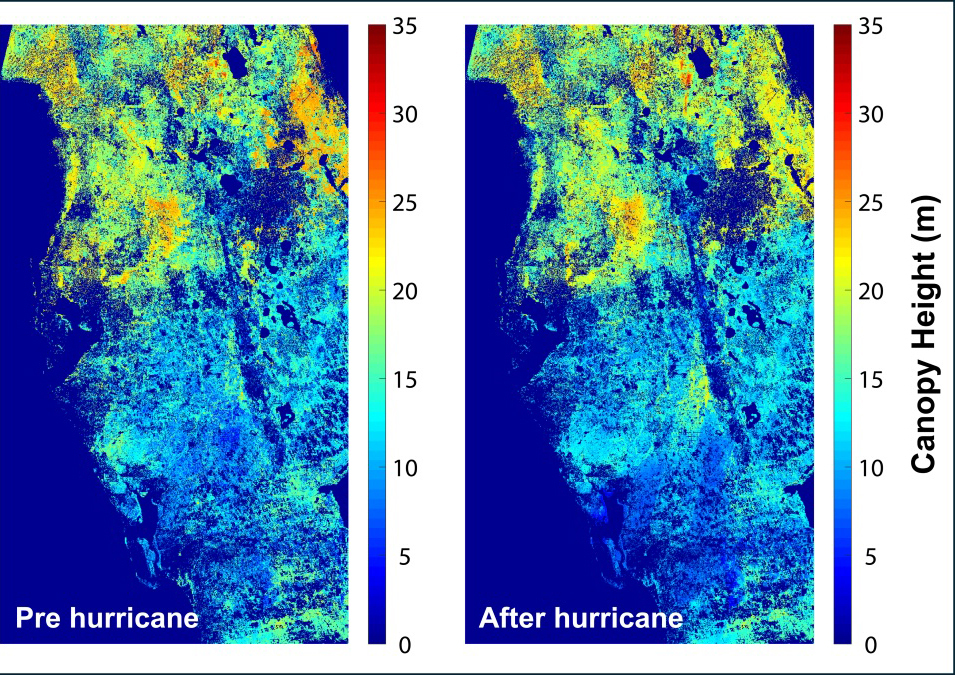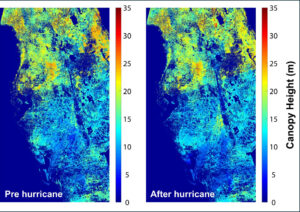[By Larisa Serbina and Holly M. Miller, USGS] Interstate compacts influence water availability within a given state. In order to stay within the appropriated allocation, water use must be measured and monitored. The Upper Colorado River Compact, which spans across Wyoming, Utah, New Mexico, and Colorado, is a great example of the vast area that must be assessed yearly/seasonally to uphold the Compact. Landsat thermal imagery is a very efficient tool for accomplishing this task. It offers consistency in measurements across the multi-state area, as well as time and cost savings compared to other measurement and monitoring approaches. Federal, State, and county agencies have been identified as users of Landsat imagery in water resource monitoring.
Case Studies:
+ Wyoming’s Consumptive Use Monitoring for Colorado River Compact
+ Idaho’s Hydrological Modeling
+ Nevada’s Consumptive Water Use Mapping

Wyoming State Engineer’s Office and Riverside Technologies, Inc.: Consumptive Use Monitoring for Colorado River Compact
The Colorado River provides water to seven states as well as the Republic of Mexico. The seven states which receive water from the river system are Arizona, California, Colorado, Nevada, New Mexico, Utah and Wyoming. Water is divided between these entities primarily based on three documents. The Colorado River Compact signed in 1922 allocates water in the basin between the lower basin states (Arizona, California and Nevada) and the upper basin states (Colorado, New Mexico, Utah and Wyoming). The International Treaty with Mexico signed in 1944 guarantees annual delivery of 1,500,000 acre-feet of Colorado River water to that country. Finally, the Upper Colorado River Basin Compact of 1948 divides the water allocated to the upper basin states between those states on a percentage basis. Language in the Upper Basin Compact requires each upper basin state to determine and report their annual consumptive use of water.
For the State of Wyoming, this reporting obligation has historically presented a considerable challenge. The vast majority of water use in Wyoming, as with most western states, occurs due to irrigation. The portion of Wyoming that drains to the Colorado River includes the Green River Basin and has over 330,000 acres of irrigated lands spread out over 17,000 square miles (mi²). In addition, water is withdrawn from surface water sources at over 2,000 individual headgates. Under these conditions, accurate on-the-ground measurement of the consumptive use of water is not only costly, but nearly impossible.
In 2009, the State of Wyoming turned to the use of remotely sensed data from Landsat and a process developed in Idaho termed METRIC (Mapping EvapoTranspiration at high Resolution with Internalized Calibration; Allen and others, 2007), to assess evapotranspiration from irrigated lands in the Green River Basin.
The METRIC model was originally developed at the University of Idaho to compute and map evapotranspiration using Landsat images. The recent Landsat satellites (5, 7, and 8) contain the necessary spatial resolution and thermal data to conduct an energy balance calculation to determine evapotranspiration at the field scale. The use of Landsat and METRIC has yielded consistent savings from a third to potentially as much as a half of the total costs compared to on-the-ground methods.

The use of Landsat data to assess the consumptive use of water across a large basin provides a savings in time and money for the State. The use of Landsat data in METRIC to estimate evapotranspiration is more efficient and accurate, as well as relatively inexpensive, when compared to traditional methods in use (Allen and others, 2005; Morse and others, 2008). The Landsat thermal band and relatively high spatial resolution are necessary for conducting energy balance analysis and determining consumptive use. Riverside Technology, inc., a private consulting firm, is currently working with the State of Wyoming by helping the state engineer’s office map consumptive use in the Green River Basin. This work is done to meet the obligation of the State of Wyoming to the Colorado River Compact administration program.

Despite the efficiencies associated with Landsat imagery use, concerns about potential problems exist. Currently there are two operating satellites: Landsat 7 and Landsat 8. Each satellite has a revisit time of 16 days, providing Landsat imagery as frequently as every 8 days. Landsat 7, however, returns an image with some missing data. Relying on imagery from Landsat 8 only, provides imagery every 16 days at best. Cloud cover on days of satellite overpass may render an image unusable, increasing the gap in imaging intervals to less than what is needed to measure evapotranspiration during a growing season. Therefore, the State of Wyoming is currently moving ahead with a program to continually measure water diverted at as many headgates as possible to ensure the state will have a “back-up” process to measure consumptive use in case of any failures in the Landsat program. This effort is expensive but necessary until an operational Landsat program can be guaranteed. Such a program would need to meet the criteria outlined by the Western States Water Council, which include ensuring the continuity of no-cost global imagery in perpetuity while retaining or improving the existing spectral bands, spatial resolution, and temporal resolution (Willardson, 2012).
Finally, although each of the upper basin states currently uses a different methodology to calculate their consumptive use, there is a study under way by the Upper Basin Commission to evaluate what it may take to conduct some monitoring of all irrigated lands in the upper basin using Landsat imagery. A consistent method across all states will hold each state accountable at the same level of accuracy and efficiency. A decision to move forward with such an effort will be based on the confidence in or certainty of a long-term Landsat program (Steve Wolff, Wyoming State Engineer’s Office, oral commun. and written commun., 2013).
Hydrological Modeling, Idaho Department of Water Resources
Idaho water law is based on the Doctrine of Prior Appropriation. The doctrine states that a water right is authorized for beneficial use based on priority date: “first in time, first in right.” Senior water-rights holders, established before the junior water rights-holders, get priority in fulfilling their water rights. In order to meet senior holders’ allocation amounts, actual and historical consumptive water use data are needed. Thus, measuring and monitoring consumptive water use in agriculture becomes an important task for Idaho hydrologists and water engineers.
In order to accomplish the task, hydrologists start by using monthly and seasonal Landsat data processed in METRIC to estimate evapotranspiration on the Eastern Snake Plain Aquifer and the Boise Valley Aquifer. Estimated evapotranspiration is an input during calibration of a groundwater model called MODFLOW. The improved accuracy of estimation of water depletions from the aquifer caused by crop evapotranspiration provided by METRIC improves model calibration. The METRIC model is also used to compute incidental recharge to the aquifer from surface water irrigation diversions (diversions – evapotranspiration – returns = recharge). The more accurately calibrated groundwater models have been used in litigation involving conjunctive use of groundwater and surface-water resources (Kramber and others, 2012). Landsat data were also used to update the Eastern Snake Plain Aquifer model. Cloud-free Landsat images from 1996, 2000, 2002, 2006 and 2008 were used to estimate monthly and seasonal evapotranspiration. Additionally, evapotranspiration estimates from as early as mid-1980s are being developed with the use of Landsat data. This will allow for the analysis of long term trends in irrigation, evapotranspiration and their impact on the aquifer (Kramber and others, 2012).

State Consumptive Use Mapping, Nevada Division of Water Resources
“Nevada territory embraces over 80,000 square miles, but it is nearly all desert.” —William H. Brewer, Up and Down California In 1860–1864

The Nevada Division of Water Resources uses Landsat imagery as one source of independent data to meet their responsibilities regarding the measurement and monitoring of agricultural water consumption within the state. Within Nevada, Landsat imagery serves as either a source of independent confirmation or as a baseline. Since Nevada has less than 3 million residents, only one state water engineer/hydrologist is responsible for monitoring a very large area of land. When questions regarding beneficial use of water in the state arise, it is the state engineer’s job to verify water use on the plot of land. Typical practices include meter readings or field investigations, which can take several days to conduct, considering travel time. The Normalized Difference Vegetation Index (NDVI) derived from Landsat imagery greatly increases the accuracy and defensibility of historic water-usage records without additional cost or time commitments. In many cases, documentation of water use from meters or field investigations is not available, and Landsat is the only independent source of data to support or refute word of mouth. Landsat imagery is pulled at least once a month by staff at the Nevada State Engineer’s Office. Landsat data are also commonly used by applicants or protestants of water-right applications for the purpose of quantifying water use.
The State is working in conjunction with the Desert Research Institute (DRI) and the University of Idaho to implement the METRIC model with Landsat data to quantify actual consumptive use of water in agricultural areas. The State is in the fourth year of a five-year grant from the Bureau of Reclamation to complete this project. The results of the project can be used to estimate seasonal and monthly agricultural water use at the basin- and field-scale and to improve water budgets and hydrologic modeling. At this time, METRIC results have not been used in any water right transfers in Nevada. Figure 7A is a false color infrared derived from Landsat for Northern Carson Valley, Nevada (prepared by Justin Huntington, DRI). Figure 7B shows evapotranspiration using energy balance in the valley. These images allow the viewer to easily delineate between irrigated and non-irrigated land (Adam Sullivan, Nevada Division of Water Resources, oral commun. and written commun., 2013).







